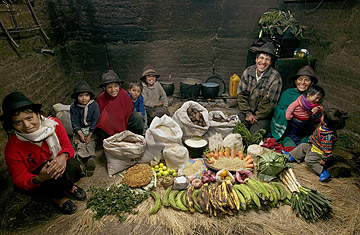
Ecuador
The Ayme family of Tingo
Food Expenditure for one week: $31.55
Cooking Method: Wood fire
(3 of 3)
Yet plenty has been lost too, even in cultures that still live to eat. Take Italy. It's no secret that the Mediterranean diet—with its emphasis on olive oil, seafood and fresh produce—is healthy, but it was also a joy to prepare and eat. Italians, says Counihan, traditionally began the day with a small meal called colazione, consisting of light baked goods and coffee. The big meal came at around 1 p.m. and included a first course of pasta, rice or soup; a second of meat and vegetables; a third, fruit course and, of course, wine. In between the midday meal and a late, smaller dinner came a small snack, the merenda. Today, when time zones have less and less meaning, there is little tolerance for offices' closing for lunch, and worsening traffic in cities means workers can't make it home and back fast enough anyway. So the formerly small supper after sundown becomes the big meal of the day, the only one at which the family has a chance to get together. "The evening meal carries the full burden that used to be spread over two meals," says Counihan.
South Americans are struggling with similar changes. John Brett, a nutritional anthropologist at the University of Colorado at Denver and Health Sciences Center, says that many Latin Americans too prefer a large family meal at midday, heavy on starchy grains like quinoa or plants like yucca. But migration from the country to the cities has made that impossible. "They don't have the luxury of two hours of lunch," says Brett. "The economy moves on." Not only do these changes add stress for families, but nutritional quality declines as well. "They tend to eat whatever is cheap and quick, " says Chaiken.
Paradoxically, the thing that has contributed the most to the deterioration of food culture may be one of the very things that has helped turbocharge countries in so many other ways: the presence of women in the workforce. "If women are working, they can't shop and cook and prepare a meal," says Counihan. "In the old days, you might have had the grandmother doing it, but family size is shrinking." And the less exposure younger generations have to the food their grandparents ate, the less they develop the sensitive palates that allow them to appreciate it. In Latin America, says Jeffery Sobal, a professor of nutritional science at Cornell University, "parents complain that they make [traditional] dishes, but the kids won't eat them. They want the things they see on television."
It shouldn't be surprising that the societies that have been most successful at retaining food cultures are the ones that have also resisted the pull of Westernization—for better and worse. In many Middle Eastern countries, extended families still live together, and women stay in the home preparing the kinds of traditional meals that women elsewhere no longer can. Diets in the Middle East also show the influence of religion; besides widely observed taboos on pork and alcohol, the fasting month of Ramadan alters Middle Eastern eating habits. While Muslims fast from sunup to sundown, Ramadan nights are marked by calorie-heavy indulgence. "The level of food consumption during Ramadan is much higher than during ordinary months," says Sami Zubaida, co-author of the book Culinary Cultures of the Middle East. Ramadan is "the fasting month that is really a feasting month," Zubaida says, hence the tendency for Ramadan weight gain.
Outside the most conservative nations in the Muslim world, it has proved difficult to hold on to the pleasures of traditional eating. But that's not to say that people don't long for the old ways all the same—inspiring movements in some nations to rediscover how Mom used to prepare a meal. In Europe, Asia and the U.S., the Slow Food movement—a kind of alimentary Greenpeace—campaigns against fast food while championing traditionally prepared meals. Bolivians regularly hold food fairs that celebrate South American staples even as they develop ways to speed up the time-intensive preparation of native meals so that Bolivians can enjoy the dishes of the past at the pace of today. Yet while we might—indeed must—clean up the worst of the fast-food excesses, trying to preserve the diets that keep us both culturally and physically healthier, no one pretends we're ever going to turn back the clock entirely. "Nobody has time anymore," laments Harvard's Watson. "Not even the French."
Nor do the harried Japanese, although there are exceptions. At a trim home in northwest Tokyo, where commuter trains rumble just outside the window, homemaker Estsuko Shinobu, 60, prepares a proper Japanese lunch, using fresh ingredients she bought that morning at the nearby supermarket. The mother of two grown children pads around the kitchen in slippers and a violet kimono, chopping Japanese radishes and carrots, carefully packing a sushi cake with tuna and vinegared rice. She serves dishes arranged on an individual tray just so, down to the direction of each set of chopsticks. She looks happy, even serene as she works, but when asked whether she has passed these skills on to her daughter, she sighs. "Of course not," Shinobu says. "She's far too busy for this."
—With reporting by Elisabeth Salemme/New York, Toko Sekiguchi/Tokyo, Ishaan Tharoor/Hong Kong and Christopher Thompson/London